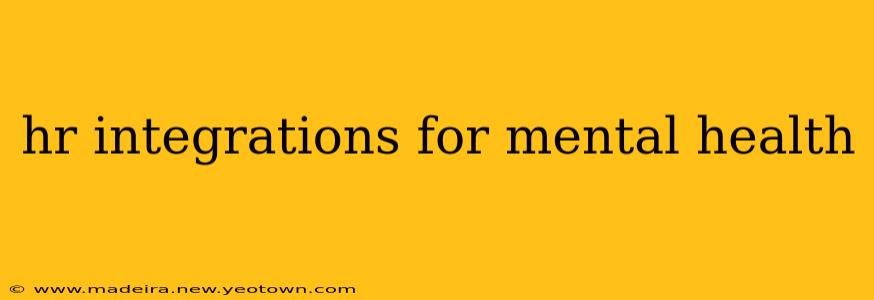The modern workplace is increasingly recognizing the crucial link between employee mental health and overall productivity. Gone are the days when mental health was a taboo subject whispered behind closed doors. Now, forward-thinking companies are actively integrating mental health support into their HR systems, fostering a culture of care and understanding. This isn't just about ticking a box; it's about creating a truly supportive and thriving work environment. Let's delve into how HR departments are revolutionizing their approach to mental wellbeing.
What are the key HR integrations for mental health?
This isn't a one-size-fits-all solution. The ideal approach depends on the size and nature of the company, its budget, and the specific needs of its workforce. However, several key integrations are emerging as best practices. These include:
-
EAP (Employee Assistance Program) Integration: Many companies already offer EAPs, but seamlessly integrating them into the HR system improves accessibility and utilization. This could involve direct links to the EAP platform from the company intranet or even integration with existing HR software for easier referral processes.
-
Mental Health Training for Managers: Equipping managers with the skills to identify signs of mental health struggles and support their employees is critical. Integrating training modules into existing HR learning platforms makes it readily available and encourages participation.
-
Mental Health Resources and Information: Easy access to reliable information on mental health conditions, treatment options, and self-care strategies is crucial. This could involve a dedicated section on the company intranet, integration with mental health apps, or curated resources within the HR system itself.
-
Benefits Integration: Ensuring mental health benefits are clearly communicated and easily accessible within employee benefits portals is vital. This includes details about coverage for therapy, medication, and other related services. A streamlined process for accessing these benefits reduces friction and encourages employees to seek help when needed.
How can HR departments improve employee access to mental health resources?
Improving access is a multifaceted challenge. Let's explore some practical solutions.
Reducing Stigma:
This is perhaps the most significant hurdle. HR can actively combat stigma through:
- Open communication: Regularly communicating the importance of mental health, sharing employee stories (with their consent), and highlighting available resources normalizes seeking support.
- Leadership buy-in: Visible support from top management demonstrates a genuine commitment to employee well-being and encourages a culture of openness.
- Confidentiality: Ensuring complete confidentiality around mental health concerns is paramount. Clear policies and procedures must be in place to protect employee privacy.
Improving Accessibility:
- Flexible work arrangements: Offering flexible work options can significantly reduce stress and improve work-life balance, supporting mental wellbeing.
- Remote access to resources: Ensuring employees can access mental health resources, such as EAPs and online therapy, remotely is vital, especially for those working from home.
- Multilingual resources: For diverse workforces, providing resources in multiple languages ensures inclusivity and accessibility.
Utilizing Technology:
Technology plays a significant role in improving access.
- Mental health apps: Integrating with mental health apps provides employees with on-demand support, tools for self-care, and easy access to professional help.
- AI-powered chatbots: These can provide initial support, answer frequently asked questions, and triage concerns, providing a convenient first point of contact.
- Data-driven insights: Analyzing usage data can help HR identify trends and areas for improvement in mental health support initiatives.
What are the benefits of integrating mental health resources into HR systems?
The benefits extend beyond simply improving employee morale. Effective mental health integration leads to:
- Increased productivity and engagement: Employees who feel supported and cared for are more likely to be engaged and productive.
- Reduced absenteeism and presenteeism: Addressing mental health concerns proactively can reduce both absences and decreased productivity from those present but not fully engaged.
- Improved employee retention: A supportive work environment fosters loyalty and reduces employee turnover.
- Enhanced company reputation: Demonstrating a commitment to employee well-being enhances a company's reputation and attracts top talent.
- Stronger company culture: Prioritizing mental health strengthens the overall company culture, fostering a sense of community and belonging.
By strategically integrating mental health support into their HR systems, organizations are not just fulfilling a social responsibility; they're making a smart business decision that benefits both employees and the bottom line. The journey towards a truly mentally healthy workplace is ongoing, but the steps outlined above provide a robust framework for building a supportive and thriving environment for all.

